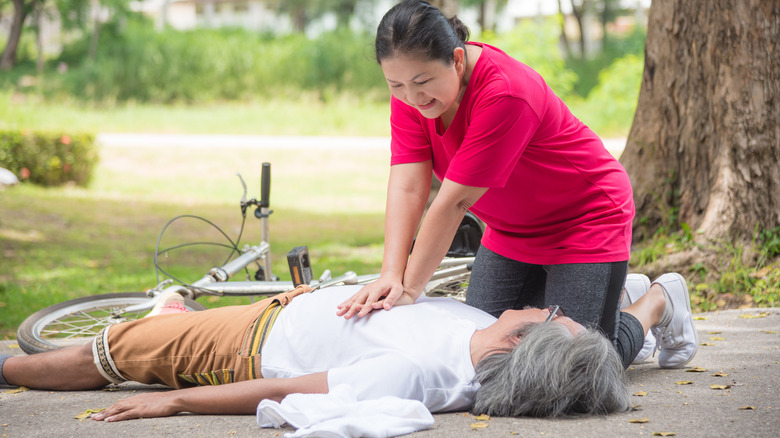How To Take Action If Someone Goes Into Cardiac Arrest
After his unexpected collapse on the football field, Buffalo Bills' football player Damar Hamlin is reported to be in critical condition after suddenly going into cardiac arrest on the field, reports NBC News. According to the American Heart Association's Heart and Stroke Statistics 2022 Update report, more than 350,000 Americans experience out-of-hospital cardiac arrests each year. Because these cases can occur in everyday places such as grocery stores, sporting events, or at home, it's important for bystanders to know how to intervene in the moment, as cardiac arrest survival rates hover at around only 10%.
First off, it can help to distinguish between cardiac arrest and a heart attack. In the case of a heart attack, blood flow to the heart has slowed as a result of a blockage in the arteries (via CNN). Meanwhile, cardiac arrest occurs when the heart has completely stopped due to an abnormal heart rhythm. While most cases come on quickly without any symptoms, those experiencing cardiac arrest may exhibit shortness of breath, weakness, dizziness, or chest pain. Dr. Christine Albert, director of the Cardiology Department at the Smidt Heart Institute in Los Angeles, tells CNN that in cases of cardiac arrest, bystanders will need to intervene within mere minutes to try and reestablish the individual's normal heart rate.
What you should do first if someone goes into cardiac arrest
First, you or someone nearby will need to call 911 for emergency medical care. Next, immediately try to locate an AED device — or automated external defibrillator — which are usually available in schools, airports, and other communal locations (per CNN). Once turned on, the machine will issue audio instructions for use, take a reading of the patient's heart rate, and dispense an electric shock if necessary.
Third, or in the absence of an AED, you'll want to administer CPR, reports CNN. The American Heart Association (AHA) states that bystanders will want to engage in hands-only CPR, meaning no mouth-to-mouth resuscitation. Individuals will want to administer 100 to 120 chest compressions per minute for adults, while pushing down hard and fast roughly 2 inches into the middle of the chest. You'll also want to be mindful not to lean your weight on the individual in between compressions. In the event that you become tired, have another person step in to continue CPR. Experts also emphasize the importance of being ready ahead of time in preparation for an emergency situation. Having a plan in place with your child's school, coach, as well as for you or your family members in terms of who will perform chest compressions or call for emergency assistance, can all help save vital time in the event that a person goes into cardiac arrest.


